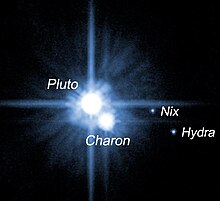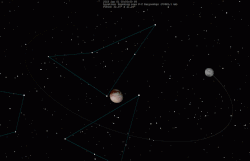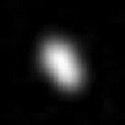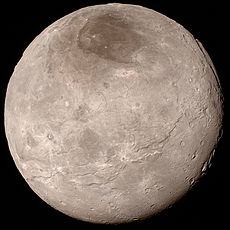Moons of Pluto: Difference between revisions
Rescuing 1 sources and tagging 0 as dead. #IABot (v1.6.2) (Balon Greyjoy) |
|||
| Line 133: | Line 133: | ||
| publisher = | location = | date = 8 January 2005 | language = |
| publisher = | location = | date = 8 January 2005 | language = |
||
| url = http://www.sciencemag.org/content/307/5709/546.abstract |
| url = http://www.sciencemag.org/content/307/5709/546.abstract |
||
| ⚫ | | doi = 10.1126/science.1106818 | id = | accessdate = 2011-07-20|bibcode = 2005Sci...307..546C | pmid=15681378}}</ref><ref name="Stern">{{cite journal |last=Stern |first=S. A. |authorlink=Alan Stern |author2=Weaver, H. A. |author3=Steff, A. J. |author4=Mutchler, M. J. |author5=Merline, W. J. |author6=Buie, M. W. |author7=Young, E. F. |author8=Young, L. A. |author9=Spencer, J. R. |title=A giant impact origin for Pluto’s small moons and satellite multiplicity in the Kuiper belt |journal=[[Nature (journal)|Nature]] |volume=439 |issue=7079 |pages=946–948 |publisher= |location= |date=23 February 2006 |language= |url=http://ns1.plutoportal.net/~layoung/eprint/Stern2006plutosat.pdf |doi=10.1038/nature04548 |id= |accessdate=2011-07-20 |bibcode=2006Natur.439..946S |pmid=16495992 |deadurl=yes |archiveurl=https://web.archive.org/web/20120119001455/http://ns1.plutoportal.net/~layoung/eprint/Stern2006plutosat.pdf |archivedate=19 January 2012 |df=dmy-all }}</ref> In both cases, the high [[Angular momentum|angular momenta]] of the moons can only be explained by such a scenario. The nearly circular orbits of the smaller moons suggests that they were also formed in this collision, rather than being captured Kuiper Belt objects. This and their near [[orbital resonance]]s with Charon (see below) suggest that they formed closer to Pluto than they are at present and migrated outward as Charon reached its current orbit. Their grey color is different from that of Pluto, one of the reddest bodies in the Solar System. This is thought to be due to a loss of volatiles during the impact or subsequent coalescence, leaving the surfaces of the moons dominated by water ice. However, such an impact should have created additional debris (more moons), yet no moons or rings were discovered by ''New Horizons'', ruling out any more moons of significant size orbiting Pluto. |
||
| doi = 10.1126/science.1106818 | id = | accessdate = 2011-07-20|bibcode = 2005Sci...307..546C | pmid=15681378}}</ref><ref name="Stern">{{cite journal |
|||
| last = Stern | first = S. A. | authorlink = Alan Stern |
|||
|author2=Weaver, H. A. |author3=Steff, A. J. |author4=Mutchler, M. J. |author5=Merline, W. J. |author6=Buie, M. W. |author7=Young, E. F. |author8=Young, L. A. |author9= Spencer, J. R. |
|||
| title = A giant impact origin for Pluto’s small moons and satellite multiplicity in the Kuiper belt |
|||
| journal = [[Nature (journal)|Nature]] |
|||
| volume = 439 | issue = 7079| pages = 946–948 | publisher = |
|||
| location = | date = 23 February 2006 | language = |
|||
| url = http://ns1.plutoportal.net/~layoung/eprint/Stern2006plutosat.pdf |
|||
| ⚫ | | doi = 10. |
||
== List == |
== List == |
||
Revision as of 16:32, 24 January 2018
| |||
(Images not to scale) |
The
History
The innermost and largest moon,
Two additional moons were imaged by astronomers of the Pluto Companion Search Team preparing for the New Horizons mission and working with the Hubble Space Telescope on 15 May 2005, which received the provisional designations S/2005 P 1 and S/2005 P 2. The International Astronomical Union officially named these moons Nix (or Pluto II, the inner of the two moons, formerly P 2) and Hydra (Pluto III, the outer moon, formerly P 1), on 21 June 2006.[2] Kerberos, announced on 20 July 2011, was discovered while searching for Plutonian rings. Styx, announced on 7 July 2012, was discovered while looking for potential hazards for New Horizons.[3]

Charon

Charon is about half the diameter of Pluto and is so massive (nearly one eighth of the mass of Pluto) that the system's barycenter lies between them, approximately 960 km above Pluto's surface.[4][a] Charon and Pluto are also tidally locked, so that they always present the same face toward each other. The IAU General Assembly in August 2006 considered a proposal that Pluto and Charon be reclassified as a double planet, but the proposal was abandoned.[5]
Small moons


Pluto's four small moons orbit Pluto at two to four times the distance of Charon, ranging from Styx at 42,700 kilometres to Hydra at 64,800 kilometres from the barycenter of the system. They have nearly circular
All are much smaller than Charon. Nix and Hydra, the two larger, are roughly 42 and 55 kilometers on their longest axis respectively,[6] and Styx and Kerberos are 7 and 12 kilometers respectively.[7][8] All four are irregularly shaped.
Characteristics


The Pluto system is highly compact and largely empty.
The orbits of the moons are confirmed to be circular and coplanar, with inclinations differing less than 0.4° and eccentricities less than 0.005. As seen from Earth, these circular orbits appear foreshortened into ellipses depending on Pluto's position.[13]
The discovery of Nix and Hydra suggested that Pluto could have a
Resonances
Styx, Nix, and Hydra are thought to be in a 3-body
All of the outer circumbinary moons are also close to mean motion resonance with the Charon–Pluto orbital period. Styx, Nix, Kerberos, and Hydra are in a 1:3:4:5:6 sequence of near resonances, with Styx approximately 5.4% from its resonance, Nix approximately 2.7%, Kerberos approximately 0.6%, and Hydra approximately 0.3%.[17] It may be that these orbits originated as forced resonances when Charon was tidally boosted into its current synchronous orbit, and then released from resonance as Charon's orbital eccentricity was tidally damped. The Pluto–Charon pair creates strong tidal forces, with the gravitational field at the outer moons varying by 15% peak to peak.[citation needed]
However, it was calculated that a resonance with Charon could boost either Nix or Hydra into its current orbit, but not both: boosting Hydra would have required a near-zero Charonian eccentricity of 0.024, whereas boosting Nix would have required a larger eccentricity of at least 0.05. This suggests that Nix and Hydra were instead captured material, formed around Pluto–Charon, and migrated inward until they were trapped in resonance with Charon.[18] The existence of Kerberos and Styx may support this idea.
Rotation
(animation; 01:00; released 10 November 2015)
Origin
It is suspected that Pluto's satellite system was
List
Pluto's moons are listed here by orbital period, from shortest to longest. Charon, which is massive enough to have collapsed into a spheroid at some point in its history, is highlighted in light purple. Pluto has been added for comparison.[15][26]
| Name ( pronunciation )
|
Image | Diameter (km) |
Mass (×1019 kg) | Semi-major axis (km) |
Orbital period (days) |
Orbital period (relative to Charon) |
Eccentricity | Inclination (°) (to Pluto's equator) |
Magnitude (mean) | Discovery date | ||
|---|---|---|---|---|---|---|---|---|---|---|---|---|
| Pluto[27] | /ˈpluːtoʊ/ |  |
2372±4 | 1305±7 | 2035 | 6.387230 | 1 : 1 | 0.0022[b] | 0.001 | 15.1 | 1930/02/18 | |
| Pluto I | Charon | /ˈʃærən/,[c] /ˈkɛərən/ |
 |
1208±3 | 158.7±1.5 | 17536±3* | 6.387230 | 1 : 1 | 0.0022[b] | 0.001 | 16.8 | 1978/06/22 |
| Pluto V | Styx | /stɪks/ |  |
16 × 9 × 8 ±?[28] | ? | 42656±78 | 20.16155±0.00027 | 1 : 3.16 | 0.0058 ± 0.0011 | 0.81 ± 0.16 | 27 | 2012/06/26 |
| Pluto II | Nix | /nɪks/ |  |
50 × 35 × 33 ±?[28] | 0.005 ± 0.004 | 48694±3 | 24.85463±0.00003 | 1 : 3.89 | 0.002036 ± 0.000050 | 0.133 ± 0.008 | 23.7 | 2005/06/15 |
| Pluto IV | Kerberos | /ˈkɜːrbərəs/ |  |
19 × 10 × 9[28] | ? | 57783±19 | 32.16756±0.00014 | 1 : 5.04 | 0.00328 ± 0.00020 | 0.389 ± 0.037 | 26 | 2011/06/28 |
| Pluto III | Hydra | /ˈhaɪdrə/ |  |
65 × 45 × 25 ±?[28] | 0.005 ± 0.004 | 64738±3 | 38.20177±0.00003 | 1 : 5.98 | 0.005862 ± 0.000025 | 0.242 ± 0.005 | 23.3 | 2005/06/15 |
The maximum distance between the centers of Pluto and Charon is 19,571 ± 4 km.
Scale model of the Pluto system
-
Pluto and its five moons, including the location of the system'sbarycenter. Sizes, distances and relative brightnessof the bodies are to scale (click on image for detail).

Mutual events

Charon has an angular diameter of 4
The smaller moons can cast shadows elsewhere. The angular diameters of the four smaller moons (as seen from Pluto) are uncertain. Nix's is 3–9 minutes of arc and Hydra's is 2–7 minutes. These are much larger than the Sun's angular diameter, so total solar eclipses are caused by these moons.
Eclipses by Styx and Kerberos are more difficult to estimate, as both moons are very irregular, with angular dimensions of 76.9 x 38.5 to 77.8 x 38.9 arcseconds for Styx, and 67.6 x 32.0 to 68.0 x 32.2 for Kerberos. As such, Styx has no annular eclipses, its widest axis being more than 10 arcseconds larger than the Sun at its largest. However, Kerberos, although slightly larger, cannot make total eclipses as its largest minor axis is a mere 32 arcseconds. Eclipses by Kerberos and Styx will entirely consist of partial and hybrid eclipses, with total eclipses being extremely rare.
The next period of mutual events due to Charon will begin in October 2103, peak in 2110, and end in January 2117. During this period, solar eclipses will occur once each Plutonian day, with a maximum duration of 90 minutes.[29][30]
Exploration
The Pluto system was visited by the New Horizons spacecraft in July 2015. Images with resolutions of up to 330 meters per pixel were returned of Nix and up to 1.1 kilometers per pixel of Hydra. Lower-resolution images were returned of Styx and Kerberos.[31]
Notes
- barycenterfor animations
- ^ a b Orbital eccentricity and inclination of Pluto and Charon are equal because they refer to the same two-body problem (the gravitational influence of the smaller satellites is neglected here).
- ^ Many astronomers use this, Christy's pronunciation, rather than the classical /ˈkɛərɒn/, but both are acceptable.
References
- ^ "Moons dance around Pluto". Smithsonian Institution. 9 June 2015. Retrieved 9 April 2016.
- ^ Green, Daniel W. E. (21 June 2006). "Satellites of Pluto". IAU Circular. 8723. Retrieved 26 November 2011. "NASA's Hubble Discovers Another Moon Around Pluto". NASA. 20 July 2011. Retrieved 20 July 2011.
- ^ "Hubble Discovers a Fifth Moon Orbiting Pluto". hubblesite.org. 29 July 2012. Retrieved 29 July 2015.
- ^ Staff (30 January 2014). "Barycenter". Education.com. Retrieved 4 June 2015.
- ^ "The IAU draft definition of "planet" and "plutons"". International Astronomical Union. 16 August 2006. Retrieved 4 June 2015.
- ^ "New Horizons 'Captures' Two of Pluto's Smaller Moons". New Horizons. Retrieved 29 July 2015.
- ^ New Horizons Picks Up Styx
- ^ Last of Pluto’s Moons – Mysterious Kerberos – Revealed by New Horizons
- ^ Bibcode:2005astro.ph.12599S.)
{{cite journal}}: CS1 maint: multiple names: authors list (link - doi:10.1086/505424.
- PMID 26040888.
- PMID 26472913. (Supplements)
- ^ "Orbits of 4 Bodies in Pluto System about Barycenter as Seen from Earth". Hubblesite. Retrieved 21 June 2006.
- ^
Pasachoff, Jay M.; Babcock, Bryce A.; Souza, Steven P.; et al. (2006). "A Search for Rings, Moons, or Debris in the Pluto System during the 2006 July 12 Occultation". Bulletin of the American Astronomical Society. 38 (3): 523. Bibcode:2006DPS....38.2502P.
- ^ PMID 26040889.
- .
- ^ Matson, J. (11 July 2012). "New Moon for Pluto: Hubble Telescope Spots a 5th Plutonian Satellite". Scientific American web site. Retrieved 12 July 2012.
- ].
- New York Times. Retrieved 4 June 2015.
- ^ "NASA's Hubble Finds Pluto's Moons Tumbling in Absolute Chaos". Retrieved 3 June 2015.
- ^ "Hubble Finds Two Chaotically Tumbling Pluto Moons". hubblesite.org. 3 June 2015. Retrieved 3 June 2015.
- ^ a b Drake, Nadia; 03, National Geographic Published June. "Pluto's Moons Dance to a Random Beat". National Geographic News. Retrieved 4 June 2015.
{{cite web}}:|last2=has numeric name (help) - ^ Ragozzine, Darin (17 October 2016). "Rapidly Rotating Regular Satellites and Tides". Planetary Society. Retrieved 12 September 2017.
- PMID 15681378. Retrieved 20 July 2011.
- PMID 16495992. Archived from the original (PDF) on 19 January 2012. Retrieved 20 July 2011.)
{{cite journal}}: Unknown parameter|deadurl=ignored (|url-status=suggested) (help - ^ Orbital elements of small satellites from Showalter and Hamilton, 2015; mass and magnitude from Buie & Grundy, 2006
- ^ Pluto data from D. R. Williams (7 September 2006). "Pluto Fact Sheet". NASA. Retrieved 24 March 2007..
- ^ a b c d Weaver et al. (2016)
- ^ "Start of Eclipse". JPL Solar System Simulator. 12 December 1987. Retrieved 29 July 2014. (Pluto as seen from the Sun during mid-eclipse)
- ^ "End of Eclipse". JPL Solar System Simulator. 12 December 1987. Retrieved 29 July 2014.
- ^ New Horizons flyby timeline
Sources
- S.A. Stern, H.A. Weaver, A.J. Steffl, M.J. Mutchler, W.J. Merline, M.W. Buie, E.F. Young, L.A. Young, & J.R. Spencer (2006), Characteristics and Origin of the Quadruple System at Pluto, Nature, submitted (preprint)
- Steffl, A. J.; Mutchler, M. J.; Weaver, H. A.; Stern, S. A.; Durda, D. D.; Terrell, D.; Merline, W. J.; Young, L. A.; Young, E. F.; Buie, M. W.; Spencer, J. R. (2006). "New Constraints on Additional Satellites of the Pluto System". The Astronomical Journal. 132 (2): 614–619. doi:10.1086/505424.
- Buie M.W., Grundy W.M., Young, E.F., Young L.A., Stern S.A. (2005), Orbits and photometry of Pluto's satellites: Charon, S/2005 P1 and S/2005 P2, submitted (preprint)
- Brozovic, M., Showalter, M. R., Jacobson, R. A., & Buie, M. W. (2015), The orbits and masses of satellites of Pluto, Icarus, 246, 317. Bibcode:2015Icar..246..317B
- IAU Circular No. 8625, describing the discovery of 2005 P1 and P2
- IAU Circular No. 8686, reporting a more neutral color for 2005 P2
- IAU Circular No. 8723 announcing the names of Nix and Hydra
- Background Information Regarding Our Two Newly Discovered Satellites of Pluto – The website of the discoverers of Nix and Hydra












